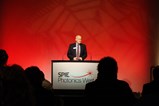Harnessing Light 2.0: Revisiting The State Of Optical Science And Engineering

By Jim Pomager
On the final morning of Photonics West 2011, SPIE hosted a special "Future of Photonics" forum designed to gather industry input for a comprehensive new study of the optics and photonics field. Erik Svedberg, senior program officer with the U.S. National Academies, and Eugene Arthurs, CEO of SPIE, moderated the event, which was attended by hundreds of Photonics West attendees.
In 1998, the National Academies and its operating arm, the National Research Council (NRC), published Harnessing Light. This 360-page study explored emerging applications for optical technology, reviewed the status of the optics industry and of research and education in optics, and identified actions that could enhance the field's contributions to society and facilitate its continued development. However, the industry — and society — has changed a great deal in the 12 years since Harnessing Light was published, and SPIE has been pressing for an update to the study for over 5 years, Arthurs said.
Well, the wait is finally over. Svedberg announced during the forum that the National Academies have started taking steps toward creating an updated version of Harnessing Light. Armed with an $850,000 budget — courtesy of the NSF, DARPA, NIST, DOE, and others — the soon-to-be-formed Harnessing Light committee will meet over the course of the next year to tackle the following issues:
- Review updates in the state of optical science that have taken place since original publication of Harnessing Light.
- Identify the technological opportunities that have arisen from recent advances in and potential applications of optical science and engineering.
- Assess the current state of optical science and engineering in the United States and abroad, including trends in private and public research, market needs, and examples of translating progress in photonics innovation into competitiveness advantage, workforce needs, manufacturing infrastructure, and the impact of photonics on the national economy.
- Prioritize a set of research grand-challenge questions to fill identified technological gaps in pursuit of national needs and national competitiveness.
- Recommend actions for the development and maintenance of global leadership in the photonics driven industry, including both near-term and long-range goals, likely participants, and responsible agents of change.
To aid the committee in its initial work, Svedberg and Arthur solicited input from forum attendees, many of whom willingly offered their feedback. Among the issues raised were:
- Creating a clearer, more coherent industry identity, one that can be easily understood by members of government and the general population
- Considering the investment community when developing the study, since that group has largely ignored the optics/photonics industry in recent years
- Engaging more young people in science education, particularly in the United States, in order to grow the next generation of scientists and engineers
- Developing better measures of optics' impact, given the fact that it is an enabling technology that is feeding many vertical industries
- Paying closer attention to the resources and materials that underlie optics technologies (e.g. glass)
- Liaising with the international community on the study, since similar efforts are already underway in various parts of the world, including the United Kingdom, Germany, and Japan
For more information on the study, please contact Erik Svedberg. His contact information can be found on the U.S. National Academies website.
